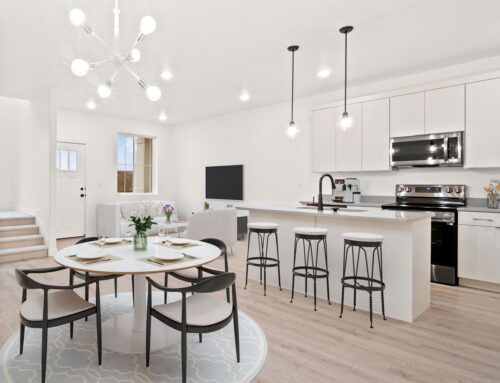Whether you want to add some style and texture to a room or want to dampen sounds on non-carpeted surfaces, an area rug can be a great addition to any room. However, you want to make sure you choose the right rug, or it can look odd and actually detract from a room. In addition to things like color, pattern, and cost, below are some things you want to consider when choosing an area rug for your home.
Pile
A rug’s pile refers to the density of its fibers, and when trying to decide on the pile, you need to consider not just the look but the usage. Low-pile rugs are generally sturdier than high-pile rugs, and they are easier to vacuum and clean. Low-pile rugs also tend to be less expensive. Because of the durability, low-pile rugs are best in rooms where there is high traffic, such as living rooms, hallways, and other common areas. High-pile rugs are softer and feel more luxurious underfoot, and they can make a room look cozier and more inviting. They work best in rooms that don’t get a lot of traffic, such as bedrooms.
Materials
Rugs come in a variety of materials, some natural fibers and other synthetic. Natural fibers include wool, silk, cotton, jute, or bamboo, while synthetic rugs include polypropylene, nylon, polyester, and microfiber. Natural fiber rugs will typically be more expensive and vary on durability. For example, wool rugs hold up well in high-traffic areas (but will shed), while cotton rugs fade quickly and are not stain-repellent. Synthetic rugs are less expensive, fade resistant, and easy to clean but may not be as durable as natural fiber ones. When choosing materials, consider where they will be placed and the amount of traffic they will get, sun and heat exposure that could affect the rugs, and if you are looking for something that will last long-term or are OK with replacing it more often.
You will also want to consider the material of the flooring you are placing the rug on. Some materials in rugs (backing made of rubber or something similar in particular) can stain hardwood, vinyl, and EVP/LVP flooring. Those flooring materials are also susceptible to scratches and tears, so make sure any material you put on them is not abrasive. If you are unsure about the area rug material and how it may affect your flooring, put a rug pad under it to protect your floor (pads also extend the life of the rug, help it stay put, and more).
Size
Getting the right size of rug for a room can be very challenging. In fact, having the wrong size of rug in a room is one of the most common decorating mistakes people make. Too-small rugs creates an unfinished floating effect that detracts from the overall look of the room. Rugs that are too big can make your room fill tight and crowded. Generally speaking, you want anywhere from eight inches to 24 inches of bare floor between the edges of the rug and the walls of a room. The amount of bare floor will depend on the size of the room, but most average-sized rooms should be in the 10 to 20 inches of bare floor space. You also need to consider the furniture you have in the room and how it will fit in relation to the area rug. Because of unique characteristics and furniture in each room in your home, there are different guidelines for each room. Here are some general rules for rooms where you may want to add a rug:
- Living Room: Crate and Barrel says you should “choose the largest area rug that makes sense in your room. A too-small rug can throw off the proportions of the space, and it’s always cozier to have more softness underfoot.” More specifically, you will want a rug that either allows all furniture on top of the rug comfortably or all the front legs to be on the rug.
- Dining Room: Your rug should be large enough that the chairs remain on it even when pushed back from the table. For a balanced look, aim to have the exposed floor around the rug be the same width on all sides.
- Bedrooms: The rug should frame the bed with the front feet of the bedside tables sitting on the edge. To achieve this look, you need a 2.5 x 6 rug for twin beds, 6 x 9 for full beds, 8 x 10 for queen beds, and 9 x 12 for king beds.
Consider Layering
What if you find a rug you love that is too small for the space? Or you want to make the area rug a focal point in the room? Considering layering rugs. Place the too-small rug on top of a larger rug. This can also help curb the costs of adding rugs. Instead of paying a lot of money for a larger higher-end rug, buy a higher-end smaller rug and place it on a less-expensive larger rug to fill out the room.
Cleaning
When looking for a rug, pay attention to cleaning instructions, particularly on rugs going in high-traffic areas. If a rug is made of material that will stain easier or may be harder to clean, placing it in a high-traffic area is probably not wise. You will want to consider the ease of cleaning as you choose rugs. When it comes to cleaning a rug, be sure to follow instructions on any cleaning agent carefully and consider testing any new agent you use in a smaller, less conspicuous area to ensure it doesn’t damage the rug.
Looking for your dream home? Liberty Homes has been building new homes in Utah for nearly 30 years. We take pride in our trade, crafting each home as if it were our own. Our quality, affordable homes are energy smart and thoughtfully personalized for your active Utah lifestyle. We currently have townhomes available in Salt Lake County, single-family homes in Heber City, and 55-plus single-family homes in West Jordan. Contact us today to find your dream home.

Want home decorating and maintenance tips, craft ideas, recipes, and more delivered right to your inbox?
Sign up for our monthly newsletter:




